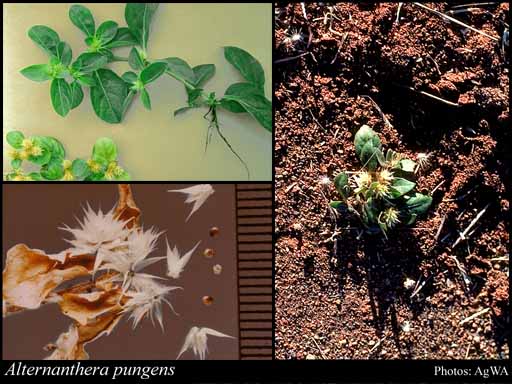- Reference
- Humb., Bonpl. & Kunth, Nov.Gen.Sp.Pl. 2:206 (1818)
- Conservation Code
- Not threatened
- Naturalised Status
- Alien to Western Australia
- Name Status
- Current
Prostrate annual or perennial, herb (with spiny inflorescences), 0.01-0.5 m high. Fl. white, Jan or Mar to May or Jul or Dec. Red-brown clay, pindan soils, laterite. Flat plains, creek banks, drainage channels, roadsides, farmyard.

Distribution
- IBRA Regions
- Avon Wheatbelt, Carnarvon, Central Kimberley, Dampierland, Esperance Plains, Gascoyne, Geraldton Sandplains, Indian Tropical Islands, Mallee, Ord Victoria Plain, Pilbara, Swan Coastal Plain, Victoria Bonaparte.
- IBRA Subregions
- Cape Range, Carnegie, Chichester, Fitzgerald, Fitzroy Trough, Fortescue, Geraldton Hills, Hamersley, Hart, Katanning, Keep, Merredin, Perth, Pindanland, Purnululu, Roebourne, Western Mallee, Wooramel.
- Local Government Areas (LGAs)
- Albany, Ashburton, Broome, Carnarvon, Christmas Island, Corrigin, Derby-West Kimberley, Dowerin, East Pilbara, Exmouth, Halls Creek, Irwin, Katanning, Kent, Moora, Narembeen, Wanneroo, Wiluna, Wyndham-East Kimberley.
Management Notes (for the Swan NRM Region)
Alternative Names. Creeping Chaffweed.
General Biology. Growth form. Herb. Life form. Perennial. Reproduction. Primarily seed, also stem and root fragments. Dispersal. Soil, animals (adhesion), tyres, clothing. Toxicity. Causes allergies in humans, poisonous to stock. Seedbank persistence. Long term, 5+ years.
Notes. Major weed of warm temperate and tropical areas around the world. Naturalised in New South Wales, South Australia, Victoria and Queensland. Forms a dense monoculture on bare ground and/or disturbed areas and capable of outcompeting native plant species. Prefers light soils, warm temperatures and sufficient moisture. Spreads vegetatively and by prolific amounts of seed that remains viable for a number of years. Fruits are indehiscent, one-seeded, and have sharp bracts or burrs which are problematic in agriculture and residential areas. Seed germinates in spring and goes on to form a dense matt during summer if adequate moisture is available. Roots develop at the nodes of the spreading stems. Has a deep, woody taproot that allows plants to regenerate following drought. The top growth dies off in winter and the dormant plant is sustained by the fleshy taproot. Declared plant in parts of South Australia and Victoria.
Additional information. Origin. Brazil, Ecuador, Peru, Venezuela. History of use/introduction. Seed contaminant, medicines. Similar native species. Alternanthera nodiflora.
Suggested method of management and control. Difficult to control as it is deep-rooted. If removing physically, cut roots well below surface and avoid spreading plant fragments. Spot spray with 1% glyphosate before flowering. Read the manufacturers' labels and material safety data sheets before using herbicides. For further information consult the Australian Pesticides and Veterinary Medicines Authority to determine the status of permits for your situation or state.
Management Calendar
| Calendar Type | Jan | Feb | Mar | Apr | May | Jun | Jul | Aug | Sep | Oct | Nov | Dec | Comments |
|---|---|---|---|---|---|---|---|---|---|---|---|---|---|
| Dormant | Y | Y | Y | ||||||||||
| Active Growth | Y | Y | Y | Y | Y | Y | Y | Y | Y | ||||
| Germination | O | O | O | O | Y | Y | Y | O | Dependant on moisture levels | ||||
| Flowering | Y | Y | Y | Y | Y | Y | |||||||
| Fruiting | Y | Y | Y | Y | Y | O | |||||||
| Manual Removal | O | O | O | O | O | O | O | O | O | O | O | O | |
| Herbicide Treatment | Y | Y | Y |
Legend: Y = Yes, regularly, O = Occasionally, U = Uncertain, referred by others but not confirmed.
References
- Brown, K. & Brooks, K. (2002) Bushland Weeds: A Practical Guide to their Management. Environmental Weeds Action Network, Greenwood.
- Hussey, B.M.J., Keighery, G.J., Dodd, J., Lloyd, S.G. & Cousens, R.D. (2007) Western Weeds. A guide to the weeds of Western Australia. 2nd Edition. The Plant Protection Society of Western Australia, Victoria Park.
- Moore, C.B. & Moore, J.H. (2002) Herbiguide, the pesticide expert on a disk. Herbiguide, PO Box 44 Albany, Western Australia, 6330.
- Parsons, W.T. & Cuthbertson, E.G. (2001) Noxious weeds of Australia. 2nd Edition. CSIRO Publishing, Collingwood.
- USDA, ARS, National Genetic Resources Program (2009) Germplasm Resources Information Network - (GRIN). National Germplasm Resources Laboratory, Beltsville, Maryland. URL: https://npgsweb.ars-grin.gov/gringlobal/taxon/taxonomysimple.aspx - Accessed October 2009.